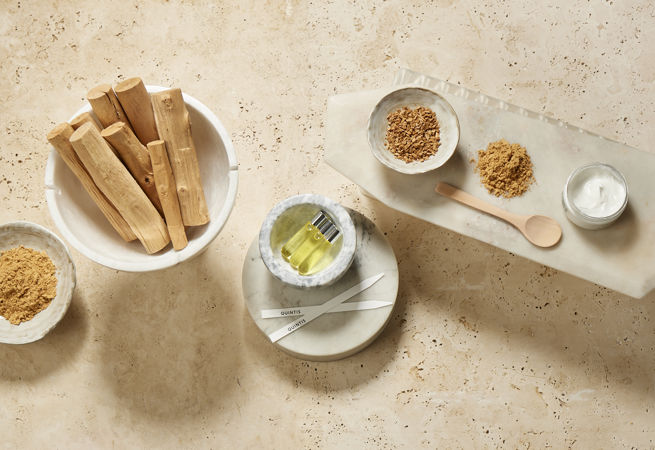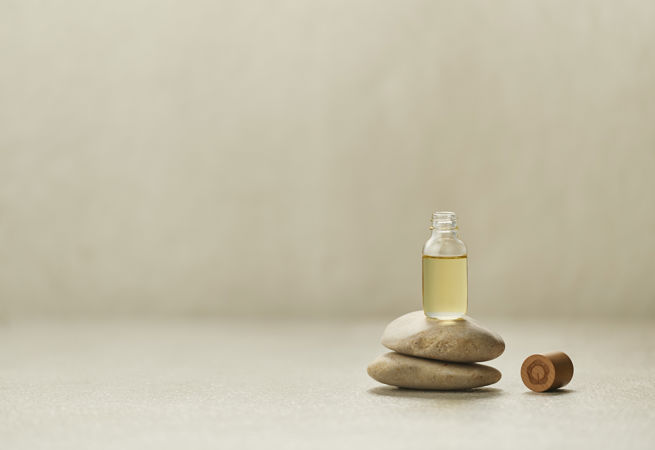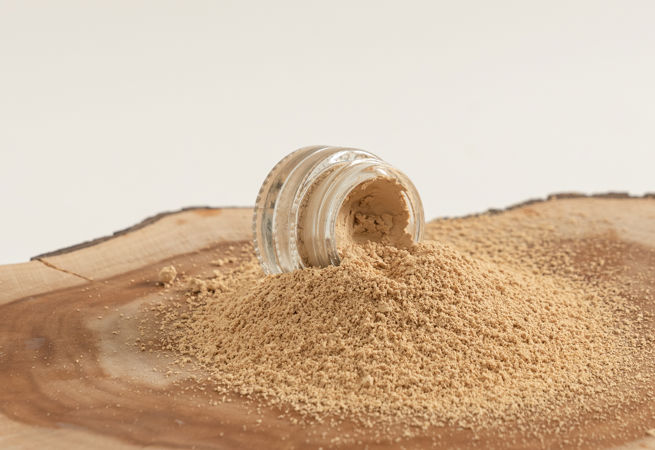
Unique Benefits, Endless Possibilities
Sandalwood has been used for thousands of years to calm the mind and relieve anxiety, reduce signs of aging and skin inflammation. It has spiritual significance and is said to bring devotees closer to god, and acts as a fixative in fragrances, ensuring they last longer on the skin.
Today, modern science not only supports traditional beliefs but reveals new ways to experience sandalwood’s benefits. Research into sandalwood and the ways in which it can heal both mind and body is ongoing, both within our business and the industry in general. Without doubt, our continual quest to share knowledge will uncover new possibilities. We look forward to finding new ways of bringing the benefits of sandalwood to the world.
Benefits overview
Sandalwood is treasured for its medicinal and healing properties – and has been for centuries. Today, ongoing research is unearthing even more unique benefits, which can be applied in a variety of ways.
Skin Treatments
Indian sandalwood oil is also known as Santalum album oil or East Indian Sandalwood Oil (EISO). It is one of the first recorded cosmetic ingredients, used by Cleopatra over 2,000 years ago and Queen Elizabeth 400 years ago. In the 6th century, Varahamihira, an ancient Hindu astronomer and polymath, wrote a famous encyclopaedic text called Brihat Samhita where he recorded 1,820 cosmetic formulations containing sandalwood. In the Tang dynasty (618-907), literature shows the use of sandalwood as a cosmetic ingredient in myriad formulations.
Indian sandalwood oil is still used today to create healthier, brighter and younger-looking skin. Numerous studies prove its efficacy in a number of key areas.
Reduce the Effects of Pollution
Pollution causes a chain reaction of dermatological events. Its noxious gases activate skin cell receptors to produce cytokines and chemokines, causing systemic inflammation and oxidative stress. This damages collagen, which in turn stimulates cortisone production, exacerbating inflammation. Indian Sandalwood oil’s anti-inflammatory and antioxidation properties can potentially help prevent skin damage in the first instance, and repair any damage that has already occurred in the second.
Reduce Signs of Ageing
As skin ages it naturally produces cortisol, which increases inflammation of the skin tissue. Indian sandalwood oil is reported to block the activity of crucial inflammatory enzymes while stimulating the activity of a deactivating enzyme. A clinical trial of the in-vitro anti-inflammatory impacts of sandalwood oil revealed startling results: over 75% of the paediatric patients with atopic dermatitis showed a 50% improvement in visual symptoms upon applying a formulation containing sandalwood oil.1
Collagen is a major protein in the skin connective tissue, essential for maintaining the shape and texture of skin. Antioxidant proteins help to protect collagen from oxidation – a major cause of wrinkles and lack of skin firmness. Indian sandalwood oil is believed to ‘supercharge’ the production of proteins that stop the oxidation process and reverse associated damage.2
Dark spots and pigmentation or sunspots are another major sign of ageing skin caused by an over-production of melanin. Sandalwood oil reportedly inhibits the major enzymes producing melanin, reducing discolouration and brightening the skin.3
Increase Alertness & Focus
Indian sandalwood is renowned for its use in relaxation and meditation. So how does something so calming also promote alertness, focus and vigour?
A study observing the physiological and mental/emotional impact of sandalwood discovered that whilst the oil acts as a relaxant physically, it is a stimulant behaviourally. The greater the decrease in systolic blood pressure, the higher the subjective rating of alertness.4 The same study shows that fragrance molecules positively interact with glutamate receptors in the brain, which play an important role in learning and memory.
Repairs Damage Caused by UV & Blue Light
Whilst Indian Sandalwood oil does not block UV or blue light emitted by digital screens, it does help repair the damage, inflammation and skin pigmentation caused post-exposure.
Relax & Be Mindful
Sandalwood has a long history of use in meditation, yoga and worship for its ability to clear the mind. Sandalwood oil is also used in aromatherapy to promote a sense of calm, relieving anxiety and tension.
It is a proven relaxant, decreasing anxiety and calming the nervous system, and assisting with better quality sleep. Its benefits are realised upon inhalation of the sweet woody fragrance or when absorbed through the skin.
According to studies, the alpha-santalol in sandalwood oil relaxes and sedates the nervous system. It is reported to act in a similar way to anti-anxiety medication, interacting with receptors in the brain that regulate anxiety.4
Relaxation methods include using sandalwood oil in a diffuser, burning the oil, using sandalwood incense sticks or a massage oil.
Manage Emotional Eating
Emotional eating generally occurs when people turn to food as a way of dealing with uncomfortable emotions. Studies show that inhaling sandalwood oil elicits a feeling of calm and suppresses negative emotions, thereby reducing the desire to eat. As muscles in the body relax, digestion improves.
Sandalwood is a proven relaxant, decreasing anxiety, calming the nervous system, and assisting with better quality sleep. Its benefits are realised upon inhalation of the sweet woody fragrance or when absorbed through the skin.
Discover our range
From religious practices to flavour enhancement, sandalwood has a range of applications across a variety of industries. Sandalwood’s sweet, woody aroma is unmistakeable, while its therapeutic benefits are now influencing a range of applications in cosmetics, fragrance and aromatherapy. Discover our range of products and how they can be used.




